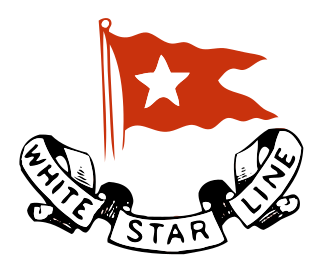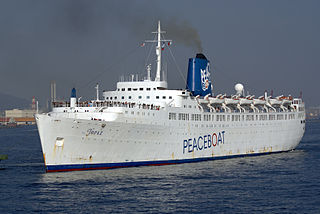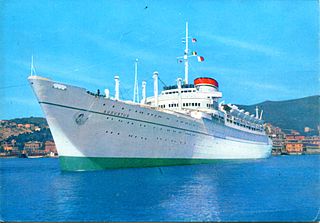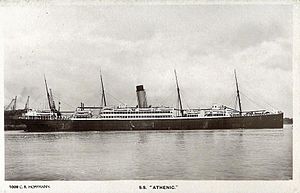
An ocean liner is a type of passenger ship primarily used for transportation across seas or oceans. Ocean liners may also carry cargo or mail, and may sometimes be used for other purposes. The Queen Mary 2 is the only ocean liner still in service to this day.
Holland America Line (HAL) is a US-owned cruise line, a subsidiary of Carnival Corporation & plc headquartered in Seattle, Washington, United States.

The White Star Line was a British shipping line. Founded out of the remains of a defunct packet company, it gradually rose up to become one of the most prominent shipping companies in the world, providing passenger and cargo services between the British Empire and the United States. While many other shipping lines focused primarily on speed, White Star branded their services by focusing more on providing comfortable passages for both upper class travellers and immigrants.

SS Oceanic was the White Star Line's first liner and first member of the Oceanic-class; she was an important turning point in passenger liner design. Entering service in 1871 for Atlantic crossings, she was later chartered to Occidental and Oriental Steamship Company (O&O) in 1875. The ship provided passenger service for O&O in the Pacific until 1895 when she was sold for scrap.

RMS Empress of Britain was a transatlantic ocean liner built by Fairfield Shipbuilding at Govan on the Clyde in Scotland in 1955-1956 for Canadian Pacific Steamships (CP). This ship — the third of three CP vessels to be named Empress of Britain — regularly traversed the trans-Atlantic route between Canada and Europe until 1964, completing 123 voyages under the Canadian Pacific flag.

SS Gothic was a passenger-cargo liner launched in December 1947, though not completed until a year later. She became the most famous of the quartet when she was designated a royal yacht from 1952 to 1954.

SS Ionic was a steam-powered ocean liner built in 1902 by Harland and Wolff in Belfast for the White Star Line. She was the second White Star Liner to be named Ionic and served on the United Kingdom – New Zealand route. Her sister ships were SS Athenic and SS Corinthic.

RMS Empress of India was an ocean liner built in 1890-1891 by Naval Construction & Armaments Co, Barrow-in-Furness, England for Canadian Pacific Steamships. This ship would be the first of two CP vessels to be named Empress of India, and on 28 April 1891, she was the first of many ships named Empress arriving at Vancouver harbor.

RMS Empress of Scotland, originally SS Kaiserin Auguste Victoria, was an ocean liner built in 1905–1906 by Vulcan AG shipyard in Stettin for the Hamburg America Line. The ship regularly sailed between Hamburg and New York City until the outbreak of war in Europe in 1914. At the end of hostilities, re-flagged as USS Kaiserin Auguste Victoria, she transported American troops from Europe to the United States. For a brief time Cunard sailed the re-flagged ship between Liverpool and New York.

A four-funnel liner, also known as a four-stacker, is an ocean liner with four funnels.

MS Augustus was a 27,090 GRT, luxury ocean liner built in 1950 for Italian Line. She was the sister ship to MS Giulio Cesare that was launched in the same year. These two ships were built to the same design, with similar specifications. After the Augustus was sold to Hong Kong, she sailed under five names. The ship was later sold to Manila Hotel and renamed MS Philippines, functioning as a static hotel. As reported by both Maritimematters, and maritime, the MS Philippines was sold for scrap in September 2011. As of December 2011, she was beached in Alang for scrapping.

MS Giulio Cesare was a luxurious ocean liner built for the Italian Line. She was a sister ship to MS Augustus which was launched in the same year. She was built for the South America service like her sister. These two ships' specification and design were very similar.

Shaw, Savill & Albion Line was the shipping line of P Henderson & Company, a British shipping management that operated trans-British, Australian and New Zealand cargo and passenger routes when P Henderson's Albion Line merged with Shaw Savill Line in 1882, lasting till 1970 when Elder Dempster Lines chartered P Henderson fleets in 1947 till 1965 when Ocean Group plc acquired Elder, Dempster, till the Suez crisis when the last 3 Henderson ships were transferred to Elder, Dempster and the Henderson label phased out.

The Kaiser-class ocean liners or Kaiserklasse refer to four transatlantic ocean liners of the Norddeutscher Lloyd, a German shipping company. Built by the AG Vulcan Stettin between 1897 and 1907, these ships were designed to be among the largest and best appointed liners of their day. These four ships, two of which held the prestigious Blue Riband, were known as the "four flyers" and all proved to be popular with wealthy transatlantic travellers. They also took great advantage of the masses of emigrants who wished to leave Europe.

SS Athenic was a British passenger liner built by Harland & Wolff shipyards for the White Star Line in 1901.

SS Corinthic was a British passenger ship, built in 1902 by Harland & Wolff and launched for the British shipping companies White Star Line and Shaw, Savill & Albion Line. She was the second of the Athenic-class ocean liners built for passenger and cargo service between Britain and New Zealand. Her sister ships were SS Athenic (1902) and SS Ionic (1903).

SS Ionic was a cargo liner initially in service with White Star Line from 1883 until 1900. She was used on the company's joint route to New Zealand with the Shaw, Savill & Albion Line. She was sold to the Aberdeen Line in 1900 and renamed SS Sophocles, and was withdrawn for service in 1906 and scrapped in 1908.

SS Sophocles was a 12,300-ton ocean liner of the Aberdeen Line launched in 1921, and later sold to the Shaw, Savill & Albion Line.
SS Corinthic may refer to:

The Oceanic class were a group of six ocean liners built by Harland and Wolff at Belfast, for the White Star Line, for the transatlantic service. They were the company's first generation of steamships to serve the North Atlantic passenger trade, entering service between 1871 and 1872.

















